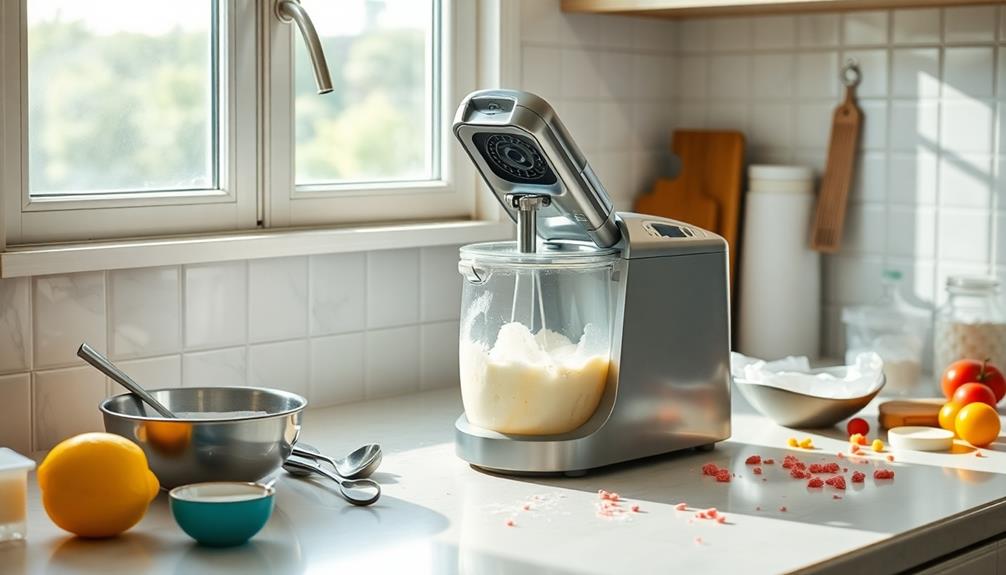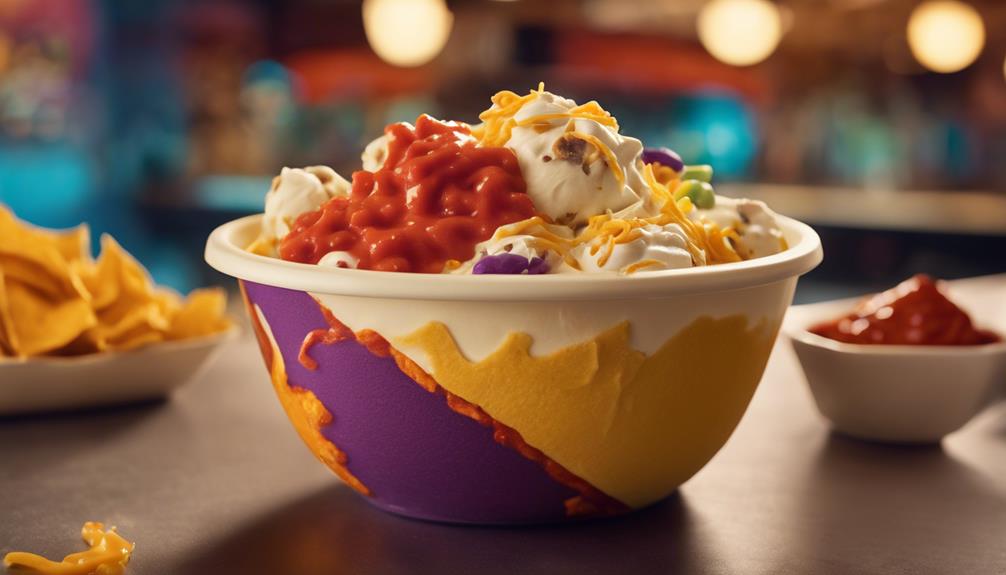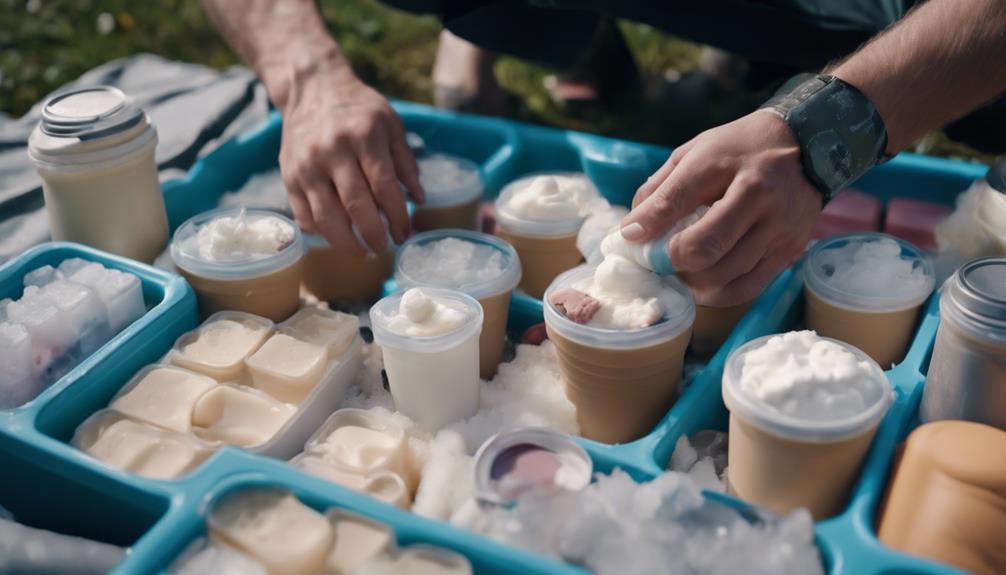To clean and maintain your ice cream maker, start by draining leftover mix and running lukewarm water through it. Disassemble the parts and soak them in warm, soapy water, then wipe down surfaces with a cloth. Sanitize all components with food-grade sanitizer and let them air dry. Remember to regularly check O-rings for leaks and lubricate them with food-safe grease. Implement a daily cleaning routine and monthly checks to guarantee proper function and hygiene. By following these steps, you can keep your machine in top shape for delicious homemade ice cream. Discover more handy tips for effective maintenance!
Key Takeaways
- Clean your ice cream maker daily by disassembling parts, washing them in warm, soapy water, and sanitizing thoroughly to prevent bacteria buildup.
- Use food-grade sanitizers like Stera-Sheen and follow guidelines for effective sanitization after each cleaning cycle.
- Regularly inspect and lubricate O-rings and seals with food-safe grease to maintain proper function and prevent leaks.
- Schedule routine maintenance checks, including monthly inspections of seals and documentation of cleaning activities to ensure compliance with health regulations.
- Troubleshoot common issues by checking power supply, ingredient proportions, and inspecting for leaks or unusual noises during operation.
Importance of Regular Maintenance
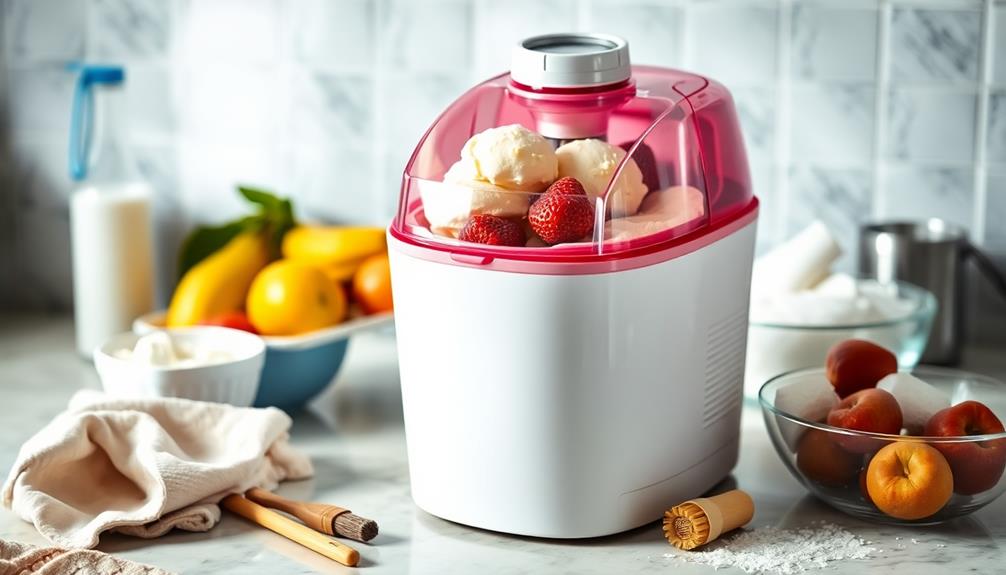
Regular maintenance is essential for keeping your ice cream maker in top shape. By consistently following a cleaning process, you not only promote food safety but also prevent the buildup of harmful bacteria, which can lead to serious health issues.
With around 48 million foodborne illnesses reported annually in the US, making sure your machine remains food safe is critical.
Moreover, regular maintenance helps extend the lifespan of your ice cream maker, saving you time and money on costly repairs or replacements. By adhering to a scheduled maintenance routine, you guarantee compliance with health regulations, reducing the risk of inspections that could disrupt your business operations.
Deep cleaning is important, as it removes old mix residue and bacteria, while also lubricating moving parts for smooth operation. This guarantees high-quality ice cream production that keeps your customers coming back.
Additionally, conducting regular checks allows you to identify potential issues early, enabling timely repairs and minimizing unexpected downtime, especially during peak hours.
Essential Cleaning Supplies
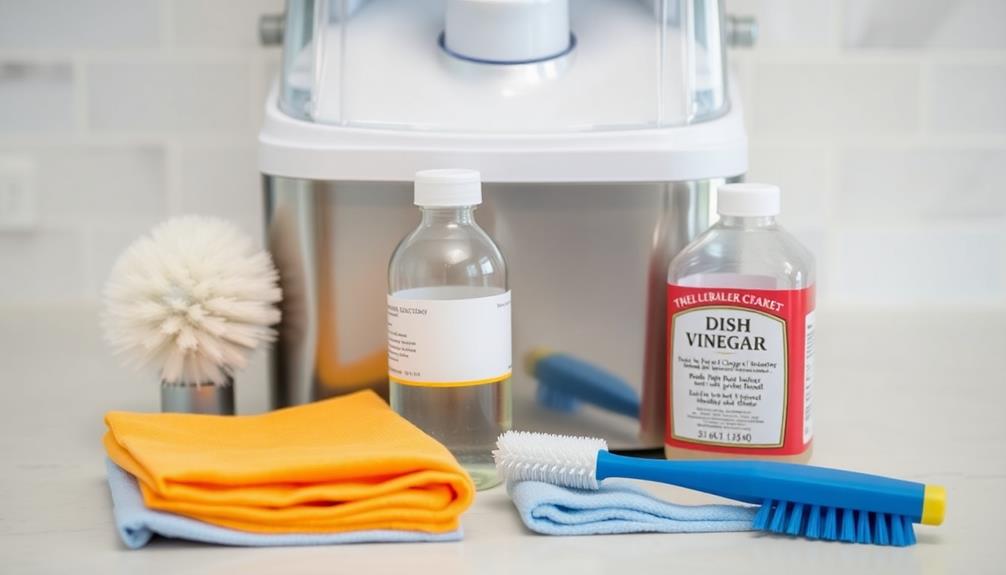
To keep your ice cream maker in top shape, you'll need the right cleaning supplies.
Start with a non-abrasive sponge, a food-grade brush, and a reliable sanitizer like Stera-Sheen.
Don't forget to have a food-safe lubricant on hand for those moving parts after cleaning.
Required Cleaning Tools
Cleaning your ice cream maker is vital for maintaining its performance and ensuring food safety. To achieve this, you need the right tools to make the task easy and effective. Here's a list of the necessary cleaning supplies you'll want to have on hand:
- Non-abrasive sponge or cloth: This helps remove residue without scratching surfaces, keeping your maker in excellent shape.
- Food-grade brush: Use this for scrubbing hard-to-reach areas, ensuring every nook and cranny is clean and free of bacteria.
- Food-safe sanitizer: An important step, this solution eliminates any lingering germs, ensuring that your ice cream remains safe to enjoy.
Don't forget to keep warm, soapy water ready for soaking disassembled parts. It effectively loosens grime and prepares them for thorough cleaning.
Also, remember to mix your sanitizing solutions according to the manufacturer's guidelines for maximum safety.
Finally, store all your cleaning supplies in a cool, dry place to maintain their effectiveness.
With these tools at your disposal, you're set to keep your ice cream maker clean and ready for delicious treats!
Recommended Sanitizing Solutions
Maintaining a clean ice cream maker goes beyond just scrubbing the surfaces; using the right sanitizing solutions is key to ensuring your equipment is safe for food preparation. Food-grade sanitizers, like Stera-Sheen, are highly recommended. Always follow the manufacturer's instructions for mixing, ensuring the right dilution ratio for maximum effectiveness against bacteria.
Here's a quick reference table for effective sanitizing solutions:
| Sanitizing Solution | Preparation |
|---|---|
| Stera-Sheen | Follow manufacturer's directions |
| Bleach Solution | 1 tablespoon per gallon water |
| Vinegar Solution | 1 part vinegar, 3 parts water |
| Quaternary Ammonium | Follow manufacturer's directions |
| Hydrogen Peroxide | 1 part hydrogen peroxide to 2 parts water |
To clean your machine effectively, prepare sanitizing solutions at the recommended strength. Always store cleaning agents away from food contact areas to prevent contamination. Refresh your sanitizing solutions every hour during use to maintain their efficacy. Finally, rinse all utensils and machine components thoroughly in warm water and sanitizing solution to eliminate any residual contaminants before reassembly.
Safe Lubrication Products
Safe lubrication products are essential for keeping your ice cream maker in prime condition. Using food-safe lubricants specifically designed for food processing equipment guarantees that you comply with health regulations while enjoying your homemade soft-serve ice cream.
Regular lubrication of o-rings and seals prevents them from drying out, maintaining a proper seal essential for peak machine performance.
Here are three key items to bear in mind for safe lubrication:
- Food-Safe Silicone Grease: This is perfect for lubricating moving parts without compromising food safety.
- O-ring Lubricant: Designed to keep seals pliable, it prevents leaks and extends the life of your machine.
- Food-Grade Mineral Oil: Use this sparingly to lubricate shafts and bearings, promoting smooth operation.
Always follow the manufacturer's guidelines for lubrication frequency and quantity.
Apply lubricants sparingly to avoid excess buildup, which can attract dust and contaminants during cleaning.
Store lubricants in a cool, dry place with tightly sealed containers to prevent contamination.
Step-by-Step Cleaning Process
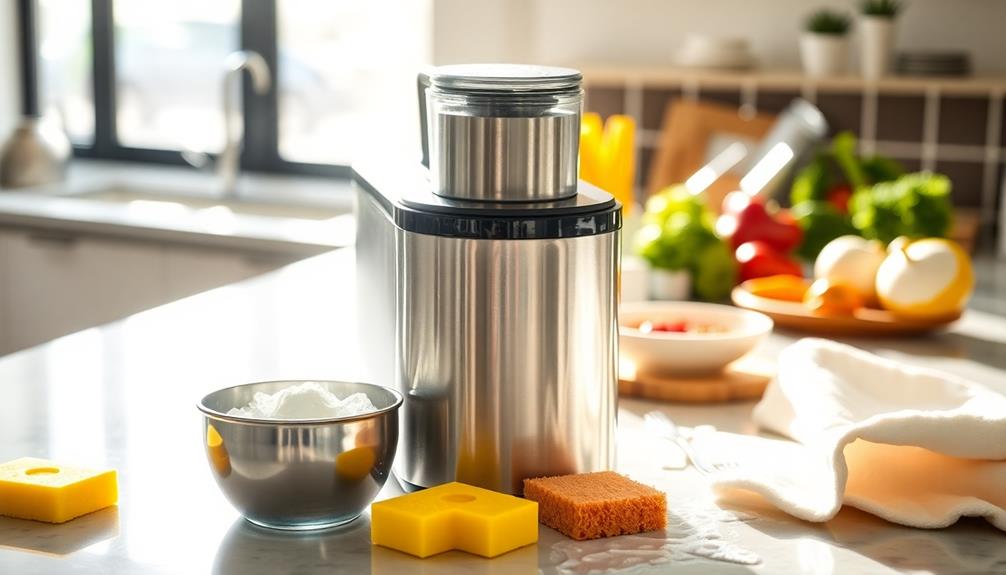
Starting the cleaning process for your ice cream maker guarantees it stays in top shape for your next batch. First, drain any remaining ice cream mix into a sanitized bucket. Next, run lukewarm water through the machine to remove any residual product.
Once you've rinsed it out, disassemble all removable parts according to the manufacturer's manual. Soak these parts in warm, soapy water for effective cleaning.
While they soak, wipe down the inside surfaces of the machine with a damp cloth to remove any mix residue.
After that, it's time to sanitize. Use a recommended food-grade sanitizer solution, following the proper dilution guidelines. Avoid bleach, as it's not safe for your ice cream maker. Sanitize all parts thoroughly and let them air dry.
Once everything is dry, reassemble the machine, lubricating specified components with a food-safe lubricant.
Effective Sanitization Techniques

When it comes to keeping your ice cream maker safe and clean, choosing the right sanitizer is essential.
You'll want to use a food-grade sanitizer like Stera-Sheen and follow the instructions for the best results.
Remember to sanitize after each cleaning cycle to protect against harmful bacteria.
Sanitizer Selection and Usage
To guarantee your ice cream maker is properly sanitized, selecting the right food-grade sanitizer is vital. Consider using a product like Stera-Sheen, specifically recommended for cleaning ice cream machines. Always mix it according to the manufacturer's directions for ideal effectiveness.
When sanitizing surfaces, make sure to cover all areas that come in contact with the ice cream mix. Here's how to do it effectively:
- Apply the sanitizer with a clean rag, ensuring thorough coverage on all surfaces and hoppers.
- Dispose of the sanitizer solution by running it through the machine's nozzles into a bucket, ensuring every part of the system is cleansed.
- Regularly check o-rings or seals for leaks; proper sealing is essential for effective sanitization and preventing contamination.
Following local health department guidelines for sanitizer usage is vital.
Remember, maintaining a clean and sanitized machine isn't just about compliance; it's about serving safe, delicious ice cream to your customers.
Prioritize your sanitizer selection and usage to keep your ice cream maker in tip-top shape!
Proper Cleaning Frequency
Maintaining a regular cleaning schedule for your ice cream maker is vital for food safety and peak performance. For soft serve ice cream machines, you should clean your machine daily to prevent foodborne bacteria buildup and comply with health regulations.
Depending on your local health department guidelines, the proper cleaning frequency can vary from once a day to every 28 days, based on usage.
After each use, disassemble all parts and hand wash them thoroughly. Rinse and sanitize to eliminate any residue and contaminants.
It's important to flush the machine using a sanitizer solution afterward, making sure all internal components are free from bacteria and safe for food contact.
Additionally, you should inspect O-rings and seals regularly. If you notice any leaks, replace them immediately to maintain peak performance and hygiene.
By sticking to this cleaning routine, you not only guarantee the quality of your soft serve ice cream but also create a safe environment for your customers.
Reassembly and Final Checks

After cleaning your ice cream maker, it's essential to verify everything is in top shape before reassembly.
Start by inspecting all parts for wear, cracks, or damage. This guarantees safe and efficient operation, so you can enjoy your homemade treats without worry.
Here's a quick checklist to guide you:
- Inspect all parts: Look for any signs of damage that could affect performance.
- Lubricate o-rings and seals: Use a food-safe lubricant to prevent leaks and guarantee proper sealing.
- Conduct a resistance test on the blades: If they show no resistance, replace them immediately for peak function.
Once you've completed these checks, you can reassemble the machine.
Don't skip the final step—run a small test batch of ice cream mix. Discard the first run to confirm everything functions properly before indulging in your creations.
This way, you'll not only maintain hygiene but also guarantee that your ice cream maker is ready for action!
Routine Maintenance Scheduling

Regular maintenance scheduling is essential for keeping your ice cream maker in prime condition. Establish a daily cleaning routine that includes disassembling parts, washing, sanitizing, and lubricating. This guarantees peak performance and hygiene, especially when you're serving delicious product mixes.
Follow your local health department guidelines for cleaning frequency, which may vary from daily to weekly based on usage. Create a maintenance schedule that involves inspecting seals and O-rings every month to prevent leaks. Document all maintenance activities and cleaning schedules to track compliance and identify any recurring issues that may need addressing.
To keep your machine running smoothly, consider setting reminders or using a calendar for timely maintenance tasks. This proactive approach can help you avoid costly repairs and guarantee consistent ice cream quality.
Here's a quick reference table to help you visualize your routine:
| Schedule | Task |
|---|---|
| Daily | Clean and sanitize all parts |
| Monthly | Inspect seals and O-rings |
| As Needed | Lubricate moving components |
Troubleshooting Common Issues
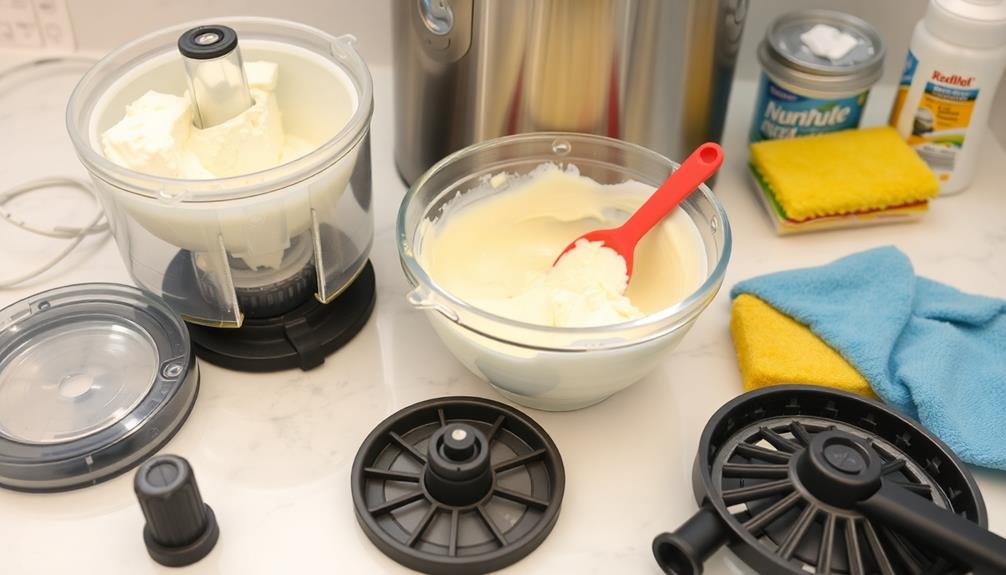
When your ice cream maker isn't performing as expected, troubleshooting common issues can save you time and frustration. Here are some common problems you might encounter:
- Not Freezing: If your ice cream machine isn't freezing, first check that the power supply is connected. Confirm that the settings are correctly adjusted for the desired ice cream consistency.
- Inconsistent Texture: If your ice cream mix has an inconsistent texture, verify the proportions of your ingredients. Improper ratios can lead to air incorporation or freezing issues, so measuring accurately is key.
- Leaks: Inspect your machine for leaks by examining seals and gaskets. Worn or damaged components should be replaced immediately to prevent further issues that could ruin your ice cream.
If you hear excessive noise, it might indicate loose parts or compressor issues. Inspect and tighten any loose fittings or consult your manual for further troubleshooting.
Document any recurring problems to expedite the resolution process and keep your ice cream maker running smoothly, guaranteeing you can enjoy delicious homemade treats without hassle!
Frequently Asked Questions
How to Properly Clean an Ice Cream Machine?
To properly clean an ice cream machine, drain any leftover mix, flush with warm water, wash components with a specialized cleaner, sanitize surfaces, inspect for wear, lubricate as needed, and test run the machine.
How to Maintain an Ice Cream Machine?
To maintain your ice cream machine, inspect it regularly. For instance, if you notice leaks after a busy weekend, check the seals and o-rings. Regular upkeep guarantees delicious ice cream and extends your machine's lifespan.
How Do You Take Care of an Ice Cream Maker?
To take care of your ice cream maker, you should regularly clean it after each use, inspect parts for wear, and follow the manufacturer's guidelines. This'll guarantee it runs smoothly and your ice cream stays delicious.
How Often Should an Ice Cream Machine Be Cleaned?
Cleaning your ice cream machine daily's as essential as breathing. You should clean it after every use to prevent bacteria buildup. Your machine's performance and the ice cream's quality depend on your consistent cleaning routine.
Conclusion
Regularly cleaning and maintaining your ice cream maker not only guarantees delicious results but also extends its lifespan. For instance, imagine a family that neglects maintenance and suddenly finds their favorite dessert machine malfunctioning during summer gatherings. By prioritizing upkeep, they could've avoided disappointment and enjoyed ice cream together instead. So, keep your ice cream maker in top shape, and you'll always be ready for those sweet moments with friends and family!
